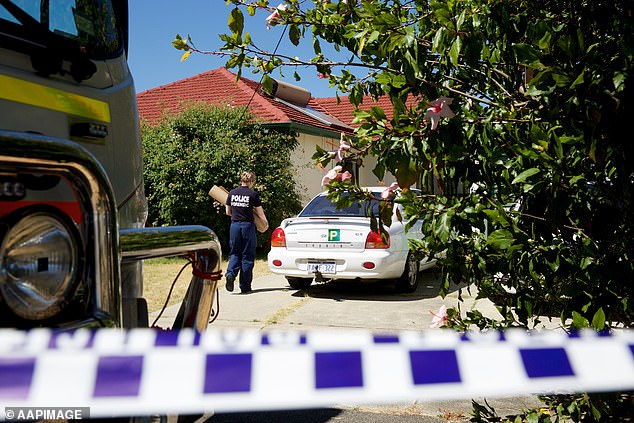Claremont serial killings: What Bradley Edwards told cops when arrested at gunpoint over three missing Perth women
The officer who kicked in the door as police arrested Claremont serial killer Bradley Robert Edwards has described the sex fiend’s breathtaking reaction when he was finally caught – calmly asking officers: ‘So what’s this all about?’
Todd Bowler was a member of Western Australia’s Tactical Response Group when he was called to participate in Edwards’ arrest, 20 years after his killing spree began.
Edwards was the prime suspect in the deaths of Jane Rimmer, Ciara Glennon and Sarah Spiers when police surrounded his home in Kewdale, Perth’s east, on December 22, 2016.
The three young women disappeared from Claremont, in the city’s west, between January 1996 and March 1997. Mrs. Spiers’ body was never found.
Mr. Bowler had been a general duty officer when the women went missing and had been driving around Claremont at the time keeping an eye out for suspicious vehicles.
When it came time to question former Telstra technician Edwards twenty years later, Bowler was keen to be involved.
“It was a pretty quiet case when it first came in because it was so high-profile and the detectives didn’t want anyone to leak the fact that they had a suspect,” he told the Crime Insiders podcast.
Mr Bowler said the operation was planned so that Edwards would be taken down without having time to resist or destroy any evidence that might be in his home.
The officer who kicked in the door when police arrested Claremont serial killer Bradley Robert Edwards (above) has described the sex addict’s calm reaction when he was finally caught.
“We had to figure out how to do that smoothly and how to keep all the evidence intact, if it was still there after all these years,” Bowler said.
“We went out that morning and sat down in the bushland near his house and had a surveillance team look at the house.”
The security team saw no movement in the home and police were therefore unable to determine whether or not Edwards was inside.
“For obvious reasons, commissioners and people high up in law enforcement wanted this man taken out as quickly as possible,” Bowler said.
“Because it would be a bad thing to leave a known serial killer on the streets, so we had to make a decision at some point.”
Since Edwards hadn’t seen a single sign since dawn, they decided the best way to determine the killer’s location was to see if they could lure him out.
“We eventually came up with a plan where we sent an undercover security agent to his house, knocked on the door, and Bradley Edwards answered the door,” Bowler said.

Bradley Edwards was the prime suspect in the deaths of Jane Rimmer, Ciara Glennon (above) and Sarah Spiers when police surrounded his home in Perth’s east on December 22, 2016
“The secret guy actually said, ‘I just saw some kids messing around with the car in the front. You might want to take a look at it.’
Bradley Edwards said, “Yes, thanks for the warning,” went outside, checked the doors of his car and all his belongings and went back inside.
“Within a few minutes we had our team assembled and we were off.”
It was Mr. Bowler’s job to break into the building through the front door.
“I punched through the front door,” he said. ‘The front door opened like a salon door.
‘The top half was broken open and the bottom half was left. It was an old wooden door, so it just rotated. So I ended up taking it apart into little pieces of wood.
“We got through it pretty quickly and then held him at gunpoint in the hallway, right through the front door.”
According to Mr Bowler, by the time police had stormed the house, Edwards was “on the floor on the carpet in the hallway, tied up face down.”

Retired police officer Todd Bowler said the operation to arrest Edwards was planned so that he would not have time to resist or destroy evidence that might be in his home (above).
So far everything had gone according to plan as other officers entered through the back and cleared every room of the house.
Mr Bowler said most offenders were “not very lippy” when TRG members pointed firearms at them, but sometimes they “get brave again” once they are away.
Edwards’ reaction, especially for someone who had never been held at gunpoint, was unlike anything Mr. Bowler had ever seen.
“He sat on the carpet for about four or five minutes while we stood over him with guns. We just wanted to make sure he didn’t do anything,” Bowler said in the podcast.
“And then he just stuck his head up and said, ‘So what’s this all about?’
“We just told him, ‘Mate, detectives will be here shortly. Keep your mouth shut, they will talk to you when they get here.’
“He said, ‘Fair enough’ and put his head back on the carpet.”
Mr Bowler said Edwards’ heart rate did not appear to exceed 50 beats per minute.
“He was just very calm and very peculiar in that way,” he told the podcast.

Todd Bowler (above) was a member of Western Australia’s Tactical Response Group when he was called to participate in Edwards’ arrest, twenty years after his killing spree began
Edwards was charged the following day with the murders of Mrs Rimmer and Mrs Glennon. He was charged with Ms Spiers’ murder in February 2018.
In October 2019, he pleaded guilty to five other charges relating to sexual assaults on an 18-year-old woman in Huntingdale in 1988 and a 17-year-old at Karrakatta Cemetery in 1995.
In June 2020, after a seven-month trial, Judge Stephen Hill found Edwards guilty of the murders of Ms Rimmer and Ms Glennon, but not guilty of the murder of Ms Spiers.
Judge Hill said it was more likely than not that Edwards had also murdered Ms Spiers and sentenced him in December 2020 to life imprisonment with a minimum term of 40 years.
Mr Bowler, who left the police force shortly after helping to arrest Edwards, said it was satisfying to end his tenure by capturing the Claremont serial killer.
“I would be surprised if anyone ever wanted to parole him because you would have to put your name next to that person,” he said. “So I don’t think he’ll be gone.”
